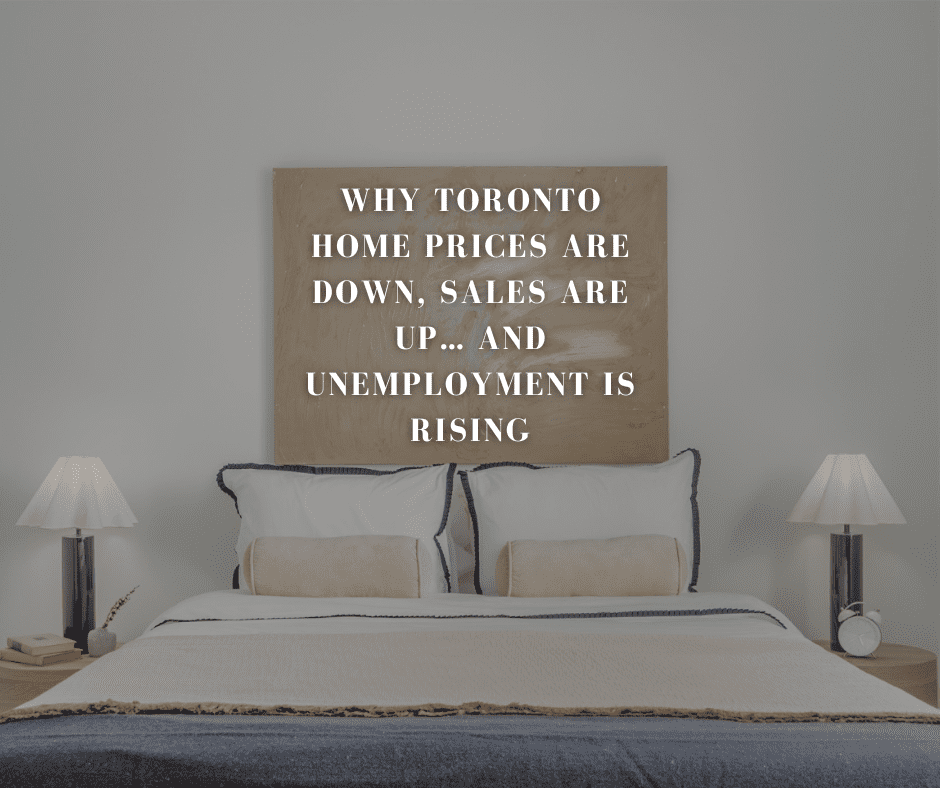August 13th, 2025 | Bidding Wars
Why Toronto Home Prices Are Down, Sales Are Up… and Unemployment Is Rising

July 2025 brought a mix of headlines for Toronto’s real estate market — some you’d expect, and some you wouldn’t.
On one hand, we saw the strongest July sales activity since 2021:
📈 6,100 homes sold, up 10.9% year-over-year, according to the latest TRREB Market Watch report.
On the other, average prices continued to slide, landing at $1,051,719, down 5.5% from last year. And quietly in the background, Toronto’s unemployment rate (seasonally adjusted) hit 8.7% in June — one of the highest levels in recent years, based on the Ontario Labour Market Report.
So, how do you square higher sales with falling prices and rising joblessness? Let’s break it down.
1. Why Sales Are Rising Despite the Economy
When prices come down and mortgage rates ease even slightly, buyer confidence starts to thaw. We’re seeing households that have been on the sidelines for months — sometimes years — finally stepping in.
- They’re finding more inventory (17,613 new listings in July, up 5.7% YoY).
- They have more negotiating power (most homes sold for ~98% of asking).
- And they’re able to buy with a little more breathing room, even if rates are still high compared to pre-2022.
Even Reuters noted that this was the biggest sales increase in nine months, with activity climbing even as prices stayed flat month-over-month.
2. Why Prices Keep Sliding
Price softening is the natural outcome of more balanced (or in this case, buyer-leaning) conditions. With 4.5 months of inventory on the market, buyers can afford to be choosy — which puts pressure on sellers to price realistically.
- Detached homes in Toronto averaged $1,572,832, down 5.1% YoY.
- Condos averaged $696,424, down 4.3% YoY.
3. The Unemployment Factor
The 8.7% unemployment rate is a wildcard. On one hand, job market instability can dampen demand if buyers are nervous about income security. On the other hand, so far the impact has been muted because:
- Many current buyers are already financially stable.
- Some are leveraging equity from previous sales rather than relying solely on income.
Statistics Canada’s Labour Force Survey shows that nationally, employment growth is slowing, and Toronto is feeling the effects more sharply than some other regions. Industry data from the CREA Toronto Employment Trends tool backs this up, noting that employment shifts could influence buyer demand later this year.
If unemployment stays elevated, it could slow the momentum we’re seeing now — particularly in the fall and winter when seasonal demand typically eases.
4. What This Means if You’re Buying or Selling
Buyers:
- This is still a negotiator’s market. Don’t rush — but don’t assume prices will keep falling at the same pace either.
- Be ready to act quickly on well-priced, turnkey properties (these are still moving fastest).
Sellers:
- If you’re also buying, the current spread between what you sell for and what you buy into can be favorable.
- Pricing strategy and presentation matter more than ever — buyers have options.
Final Word
This market is a balancing act between affordability gains and economic headwinds. As long as borrowing costs remain stable or ease further, we’ll likely keep seeing decent sales activity — but the unemployment rate is a metric worth watching closely.










